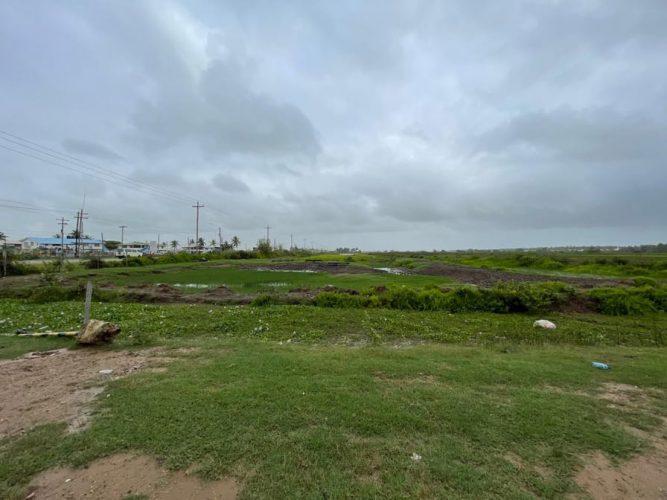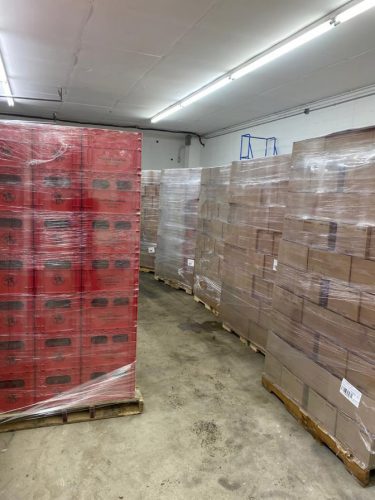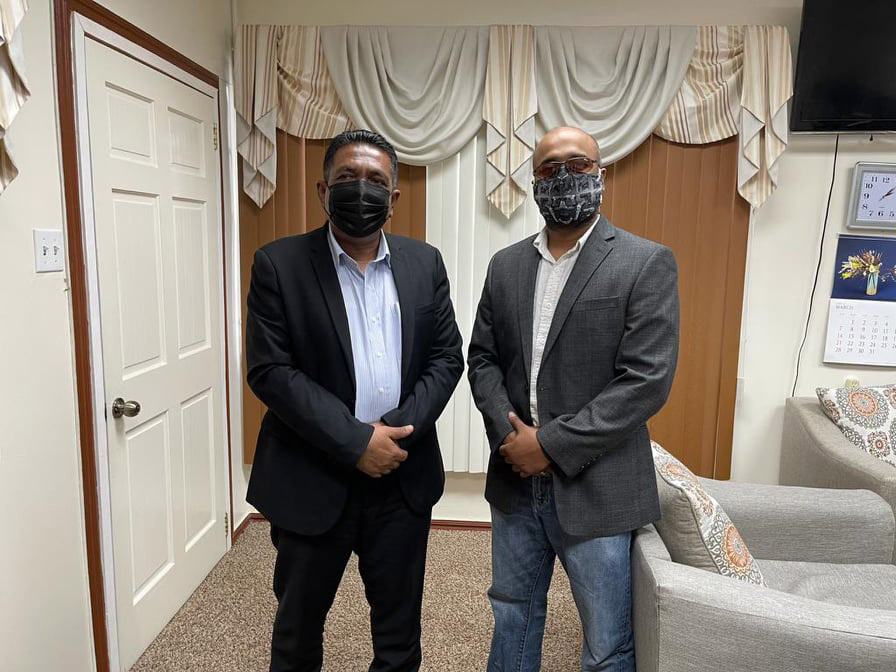Canada-based Guyanese Omkaar Sharma will be investing around $75 million (CDN$450,000) in a Region Five plant to bottle farmers’ milk for sale across the country.
Sharma told the Sunday Stabroek that the plant will initially produce 100 gallons per day and could be swiftly pumped up to 800 gallons a day depending on the supply from farmers.
Under the umbrella of the Amaya Milk company, Sharma said, the milk processing facility will be underpinned by the advocacy of renewables and incentivising locals.

“There is no current facility like this in the country. You have a number of programmes for marketing and with the school feeding programme you can have a market. From an economic perspective also, it is good for everyone,” he said.
And given that Region Five leads the country in cattle farming on the coastland, Sharma told the Sunday Stabroek that when he discussed the investment idea with the Ministry of Agriculture, he was advised it would be the best location to set up his facility.
He recently clinched a lease for land at Onverwagt for the construction of the facility and preparatory works are set to begin from next week. When it is completed, the bottled milk, under the Mahaica Dairy Milk brand, will go on sale at local supermarkets throughout the country.
Containers with equipment for the processing plant and glass bottles for the milk were last week shipped and by the time the construction is finished by June, Sharma said that set up and installation would commence. Most of the equipment, he said, he was able to acquire from a now shuttered Canadian plant while the remainder he was “able to secure at reduced prices” from persons that he knows in the industry.

A former employee of a similar facility in Canada, Sharma said he took to researching the possibilities and spoke with local farmers in the region. He was satisfied by the feedback given and decided to invest the monies he received from his previous place of employment when its operations were shuttered after its owners went into retirement.
Government, through the office of Investment (G-INVEST), last month signed a Memorandum of Understanding with Sharma for the operationalising of the facility, which will sell bottled pasteurized milk when it is commissioned, scheduled for late July of this year.
Try milk
In an interview with the Sunday Stabroek, Sharma explained why he chose investing his retirement monies in milk and explained how beneficial he believes the venture could be for Guyanese and the local economy.
“I’m at the point in my life where I needed to make a decision, because I was given the opportunity to buy the company that I was working for in Canada, but I realized that if I made that choice, I can pretty much rule out moving back to Guyana. I would be able to visit but not live, so I decided the take the same [monies from that] and put it towards this project, where I can make a meaningful contribution to Guyana while living the life I want,” he said. He explained that he budgeted for the start-up capital to be around CDN$500,000 but from current figures it will be around CDN$450,000.
“This is my home. In the 18 years that I’ve lived in Canada, I’ve been back here at least 16 times and every time, getting back on that plane to head north was just as hard as it was the first time. I’ve always known that regardless of what I’ve achieved abroad, I will never be as happy there as I am here,” he said of choosing to invest here.
Asked why he chose milk to invest in, he related that the drink is also personal him, “I love milk; it’s a naturally nutritious drink, it does so much to support a healthy gut ecosystem, everyone knows the benefits of milk. It’s the perfect drink! If you’re hot, take a cold glass of milk. You are cold? Take a warm glass of milk. Can’t sleep? Then some brandy in a warm glass of milk.”
Sharma’s love for the industry came when he got a job as an engineer at a dairy plant.
“I started working in the automotive industry in Canada, went to school for that etcetera, but when I started working in the dairy industry over there, it blew my mind. Coming from Guyana and being accustomed to bucket and perhaps (bench) being the tools for milking a cow, it was amazing for me to see that the equipment and processes for milking and processing to be every bit as sophisticated as what I was accustomed to in the automotive sector,” he related.
“Then I would come back to Guyana and when I want fresh milk, first it’s almost impossible to get in Georgetown. And when you do find people with cows, it’s still bucket and (bench). Imagine I’m working on world class dairy operations in Canada and the US and I come back here and see how much far back our dairy sector is. It was aggravating, because we have so much green and we have cattle, but still we are drinking imported milk, which is nowhere as nutritious as fresh milk. Over time that aggravation became a revelation and motivation and I started thinking that it would be a fantastic opportunity to do something I enjoy in this place that I love so much,” he added while pointing to photos of aspects of the operations.
Financial incentive
Already, he has an agreement with five large-scale cattle farmers in Region Five and they have promised to deliver 100 gallons of fresh cow’s milk every day to his plant. He says that as sales pick up, he hopes that more farmers buy into the initiative and he will gain additional suppliers. The 100 gallons per day requirement, he explained, was the minimum processing capacity as it “doesn’t make any sense to start with less than 100 gallons per day.”
“Currently, there is no financial incentive for local cattle farmers for milk. Over time, if they know there is a market and demand, more will want to join. You will also see them improve the standard of not only feeding of the cows but overall sanitization,” he said.
In terms of direct job opportunities at the plant, he said it will only be about 15 persons needed but as it expands there will be more employed.
But he was quick to point out that economic benefits would be seen in the region as the farmers would have a market for their produce while the monies earned will go back into the development of the region and by extension this country’s economy. “My aim is to work with the farmers in that area and as I establish a market for that milk and they know that, it will encourage them and other farmers to join in,” he said.
While he admits that a fresh milk market might see reluctance from a population accustomed to powered milk usage, he said that when locals realize the easy access and are aware of the benefits it brings compared to what they have, they will switch.
“We use powered milk because we haven’t had a choice for so long. I think once the product is of the standard it will have and is readily available, the choice will change. Milk is not just about calcium. There is so many other benefits. Fresh milk is about gut health too. You hear about probiotics and all of that, all that is in the cow’s milk. People know what quality is and will change,” he asserted.
“I do not expect automatic adoption but I believe consumers, especially Guyanese, know a good product and will be smart enough to understand the benefits of this good quality nutritious product,” he added.
Glass
On packaging, Sharma said that the milk would be sold in glass bottles. Explaining his choice, he said that as the world moves towards renewable and greener technologies, he wanted to see the same for his business. Noted too was that milk has to be in certain controlled temperatures and for warmer climates like Guyana, he felt it best to use glass.
“I chose glass, because I believe that while plastic is an amazing product, it is being overused to the detriment of our planet, our fishes and our people. Plastics have its place, but that place is not in our food packaging. Studies after studies have been done showing that plastics leach its chemicals into the product that it’s being used to contain. I do not want to contribute to that problem. Further Guyana does not have adequate recycling facilities,” he said, while pointing out that on his way to the interview location, he was shocked to see the canals and streets littered with plastic bottles.
In addition, he said that customers would be paid for return of bottles and caps. “The way I envision it is that you can either return to the supermarket with your empty bottle and you get a reduction. I haven’t yet worked out the numbers but my plan is to also have a system where you have a cap return: say you bring back fifty caps and get a bottle of milk or something like that. This will be a really super ecological operation; creating no harm or pollution to the environment,” he explained.
Noted too was that given that butter, ice cream and cheese are heavily imported, the more milk produced can also pave the way for other investments in the production of those items. “They don’t have a reason to milk their animals but when they see the possibilities, all of this will change,” he said.
For Guyana’s Minister of Agriculture Zulfikar Mustapha the investment in the plant is “a good one” and one government embraces not only for bringing green technologies with agriculture but for its overall benefits and opportunities. Mustapha said that his ministry will do all it can to see similar initiatives throughout the country while looking at ways of assisting farmers to create revenue.
“This will greatly help farmers to sell their milk and create jobs for them, which in turn brings in needed revenue in the region and the country,” he said.
“We are here to help and provide support to the farmers so we always welcome initiatives where farmers can develop their potential and earn needed revenue,” he added.
The Ministry of Agriculture is working with local farmers in Region Five and Region Six to maximise their earning potentials.
It is hoped that milk from the facility could be used to supply government’s countrywide public school feeding programme.
“In that area you have the largest set of cattle being reared. He will have a good supply to ensure the facility being built will be at optimal use and that area has the potential to increase it and we will help them to achieve that”, Mustapha told the Sunday Stabroek.
“This year we are working to develop already identified areas for expansion of cattle pasturing with the MMA. It is multi-phased and phase one had lands set aside specifically for rice cultivation and cattle pastures. We have moved into the second phase which is to increase and develop some more lands,” he added.





